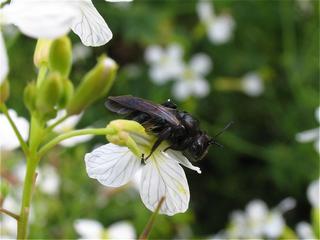 |
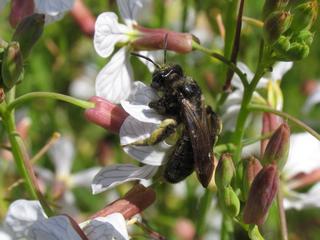 |
| Andrena nigrospina pictures by Rosemary Winnall | |
Worcestershire Record No. 23 November 2007 pp. 31-32
Geoff Trevis
This very short article briefly reviews the aculeate hymenoptera records for the year. Brevity is largely due to a poor season for this group caused, one suspects, by the very adverse weather conditions during the peak breeding period in June. The problem may have been due directly to flooding and heavy rain making nesting impossible or very difficult for many species or to the paucity of pollen and nectar resources in many places. However, though the number of records was substantially down the quality of species recorded has been high.
Most people will have heard of the finds on and near the north-western heathlands. Record of the year must go to Upper Blackstone Farm where a large, black mining bee of the genus Andrena was found by a number of recorders. This is almost certainly Andrena nigrospina though there is an outside chance that it is the less rare, though nonetheless uncommon, bee A. riparia from which morphological distinction is difficult. Even national experts were not prepared to commit 100% and next year we hope to collect another specimen for DNA analysis. A. riparia is mainly coastal in distribution and its peak breeding season is different to that of A. nigrospina (though they do overlap). Hence, on grounds of location and date we felt that A. nigrospina is the most likely. The first specimen identified was sent to me by Harry Green and I did have an initial false start on the identification of such a rare specimen, but priority goes to Rosemary Winnall who had collected one earlier in the year. Dave Barnett added further records from farmland adjacent to Upper Blackstone farm. A. nigrospina has been found at only four or five sites nationally, the nearest being in south Staffordshire, and it is an RDB species.
 |
 |
| Andrena nigrospina pictures by Rosemary Winnall | |
The second important find was Dasypoda hirtipes, another mining bee. A substantial colony is breeding at Burlish Top and several good photographs were taken of the females digging their nests during the Worcestershire Recorders meeting on 4th August. There was an additional record sent by Nigel Jones who photographed a female at Blackstone Country Park. A number of other hymenoptera were also collected at Burlish Top, among them three D. hirtipes males. This species is distinctly uncommon and is nationally notable b (Nb). Incidentally, there seems to be some slight uncertainty about nomenclature. Most current authorities use D. hirtipes but one article I was reading implied that D. altercator has priority and should be the name used. I will stick with the majority for the present.
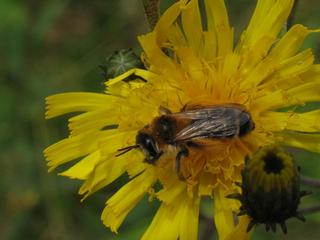 |
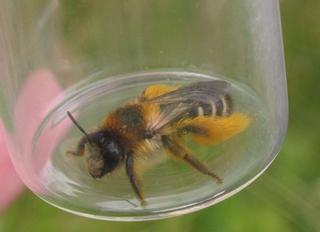 |
| Dasypoda hirtipes (female) pictures by Rosemary Winnall. Note the extremely hairy back legs | |
On 25th August members of the Wyre Forest Study Group spent a day looking at ants and, in particular, assessing the status of the slave maker ant Formica sanguinea. It is pleasing to report that the search was successful and several F. sanguinea nests were found along the old railway track. Others were found over the county boundary in Shropshire but it as good to know that this uncommon ant is still present and breeding in the forest. F. sanguinea is a slave maker on Formica fusca and this latter species was found in association with F. sanguinea at the nest sites.
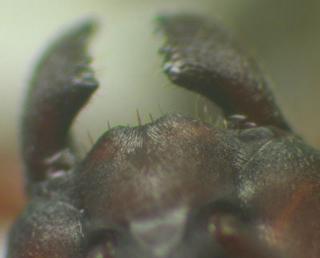 |
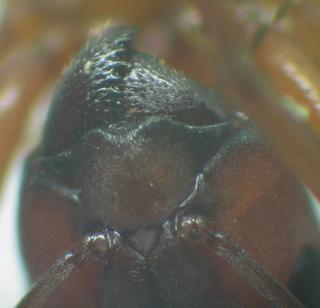 |
| The two pictures above by Harry Green show the characteristic clypeal notch of Formica sanguinea which distinguishes the species Formica rufa from the commoner Wood Ant . This is a tricky character to use in the field when examining live ants as shown in the picture below right by Rosemary Winnall | |
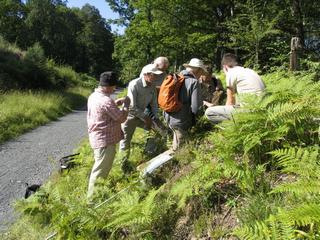 |
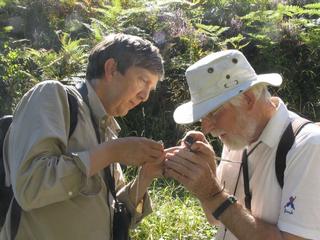 |
| The picture above left by Rosemary Winnall shows members of the Wyre Forest Study Group in search of Formica sanguinea | |
During the year I have received specimens or records of 89 species of aculeate. Most, as expected, were of relatively common species but, in addition to the those mentioned above there were records of Andrena bimaculata (Nb, Upper Blackstone Farm), A. congruens (Na, Tiddesley Wood), A. humilis (Nb, Wimperhill Wood), A. labiata (Na, Little Comberton), A. tibialis (Na, Upper Blackstone Farm), A. trimmerana (Nb, Kemerton Lakes), Chrysura radians (Na, near Bliss Gate), Eucera longicornis (Na, Joan’s Hole, Heightington), Lasioglossum malachurum (Nb, Kemerton Lakes), Lasioglossum pauxillum (Na, Tiddesley Wood, Wick Grange Farm, Roxel Site Summerfield), Lasioglossum xanthopus (Nb, Hollybed Common), Microdynerus exilis (a mason wasp, Nb, Broadway Gravel Pit), Nomada integra (Na, near Bliss Gate) and N. lathburiana (currently RDB but due to be down graded), Tiddesley Wood.
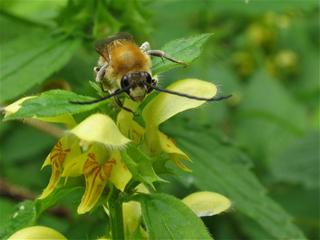 |
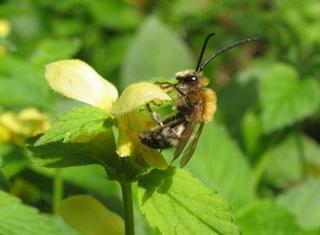 |
| Eucara longicornis pictures by Rosemary Winnall | |
I would like to thank everybody who sent me specimens or submitted records.
| WBRC Home | Worcs Record Listing by Issue | Worcs Record Listing by Subject |